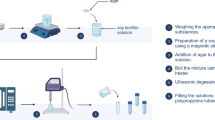Abstract
Purpose
Our purpose was to investigate the utility of superparamagnetic iron-oxide nanoparticles (SPIO) as a blood-pooling contrast agent at magnetic resonance imaging (MRI).
Materials and methods
We studied four contrast agents: carboxymethyl-diethylaminoethyl dextran magnetite SPIO (CMEADM-S, diameter 54 nm), negatively charged CMEADM ultrasmall SPIO (CMEADM-U, 32 nm), alkali-treated dextran magnetite SPIO (ATDM-S, 55 nm), and ATDM ultrasmall SPIO (ATDM-U, 28 nm) carrying a neutral charge. Each contrast agent (80 μmol/kg) was injected intraperitoneally into apolipoprotein E (apoE) mice and the tissue iron concentration was measured 30-, 60-, 180-, and 300-min later by nuclear MR. For MR angiographic (MRA) evaluation, we injected the agents into the auricular vein of four groups of 15 rabbits. Immediately and 30-, 60-, 180-, and 300-min later, three rabbits from each group were subjected to MRI. The organ/background signal ratio (SR) was calculated. Statistical analyses were performed with Tukey’s honestly significant difference (HSD) test.
Results
At 60 and 180 min, blood-iron concentration of CMEADM-U was significantly different from other contrast agents. In the abdominal aorta and inferior vena cava, SR of CMEADM-U was higher at 180 and 300 min than of the other contrast agents. In the thoracic aorta, there was no difference in SR at 300 min between CMEADM-U and CMEADM-S.
Conclusion
Negatively charged SPIO nanoparticles may be useful as a blood-pooling contrast agent.


Similar content being viewed by others
References
Wang YX, Hussain SM, Krestin GP. Superparamagnetic iron oxide contrast agents: physicochemical characteristics and applications in MR imaging. Eur Radiol. 2001;11(11):2319–31.
Raynal I, Prigent P, Peyramaure S, Najid A, Rebuzzi C, Corot C. Macrophage endocytosis of superparamagnetic iron oxide nanoparticles: mechanisms and comparison of ferumoxides and ferumoxtran-10. Invest Radiol. 2004;39(1):56–63.
Arbab AS, Liu W, Frank JA. Cellular magnetic resonance imaging: current status and future prospects. Expert Rev Med Devices. 2006;3(4):427–39.
Corot C, Port M, Guibert I, Robert P, Raynal I, Robic C, Raynaud JS, Prigent P, Dencausse A, Idee JM. Superparamagnetic contrast agents. In: Modo MMJ, Bulte JWM, editors. Molecular and cellular MR imaging. 1st ed. London: CRC Press; 2007. p. 59–84.
Saito K, Shindo H, Ozuki T, Ishikawa A, Kotake F, Shimazaki Y, et al. Detection of hepatocellular carcinoma with ferucarbotran (resovist)-enhanced breath-hold MR imaging: feasibility of 10 minute-delayed images. Magn Reson Med Sci. 2008;7(3):123–30.
Yoo HJ, Lee JM, Lee JY, Kim SH, Kim SJ, Han JK, et al. Additional value of SPIO-enhanced MR imaging for the noninvasive imaging diagnosis of hepatocellular carcinoma in cirrhotic liver. Invest Radiol. 2009;44(12):800–7.
Park HS, Lee JM, Kim SH, Chang S, Kim SJ, Han JK, et al. Differentiation of well-differentiated hepatocellular carcinomas from other hepatocellular nodules in cirrhotic liver: value of SPIO-enhanced MR imaging at 3.0 Tesla. J Magn Reson Imaging. 2009;29(2):328–35.
Saokar A, Gee MS, Islam T, Mueller PR, Harisinghani MG. Appearance of primary lymphoid malignancies on lymphotropic nanoparticle-enhanced magnetic resonance imaging using ferumoxtran-10. Clin Imaging. 2010;34(6):448–52.
Hekimoglu K, Ustundag Y, Dusak A, Kalaycioglu B, Besir H, Engin H, et al. Small colorectal liver metastases: detection with SPIO-enhanced MRI in comparison with gadobenate dimeglumine-enhanced MRI and CT imaging. Eur J Radiol. 2011;77(3):468–72.
Ishigami K, Tajima T, Fujita N, Nishie A, Asayama Y, Kakihara D, et al. Hepatocellular carcinoma with marginal superparamagnetic iron oxide uptake on T2*-weighted magnetic resonance imaging: histopathologic correlation. Eur J Radiol. 2011;80(3):e293–8.
Harnan SE, Cooper KL, Meng Y, Ward SE, Fitzgerald P, Papaioannou D, et al. Magnetic resonance for assessment of axillary lymph node status in early breast cancer: a systematic review and meta-analysis. Eur J Surg Oncol. 2011;37(11):928–36.
Allkemper T, Bremer C, Matuszewski L, Ebert W, Reimer P. Contrast-enhanced blood-pool MR angiography with optimized iron oxides: effect of size and dose on vascular contrast enhancement in rabbits. Radiology. 2002;223(2):432–8.
Wacker FK, Wendt M, Ebert W, Hillenbrandt C, Wolf KJ, Lewin JS. Use of a blood-pool contrast agent for MR-guided vascular procedures: feasibility of ultrasmall superparamagnetic iron oxide particles. Acad Radiol. 2002;9(11):1251–4.
Du J, Thornton FJ, Mistretta CA, Grist TM. Dynamic MR venography: an intrinsic benefit of time-resolved MR angiography. J Magn Reson Imaging. 2006;24(4):922–7.
Simon GH, von Vopelius-Feldt J, Fu Y, Schlegel J, Pinotek G, Wendland MF, et al. Ultrasmall supraparamagnetic iron oxide-enhanced magnetic resonance imaging of antigen-induced arthritis: a comparative study between SHU 555 C, ferumoxtran-10, and ferumoxytol. Invest Radiol. 2006;41(1):45–51.
Kawaguchi T, Hanaichi T, Hasegawa M, Maruno S. Dextran-magnetite complex: conformation of dextran chains and stability of solution. J Mater Sci Mater Med. 2001;12(2):121–7.
Reimer P, Bremer C, Allkemper T, Engelhardt M, Mahler M, Ebert W, et al. Myocardial perfusion and MR angiography of chest with SH U 555 C: results of placebo-controlled clinical phase 1 study. Radiology. 2004;231(2):474–81.
Amemiya S, Akahane M, Aoki S, Abe O, Kamada K, Saito N, et al. Dynamic contrast-enhanced perfusion MR imaging with SPIO: a pilot study. Invest Radiol. 2009;44(9):503–8.
Tsuchiya K, Nitta N, Sonoda A, Nitta-Seko A, Ohta S, Otani H, et al. Histological study of the biodynamics of iron oxide nanoparticles with different diameters. Int J Nanomed. 2011;6:1587–94.
Sigovan M, Bessaad A, Alsaid H, Lancelot E, Corot C, Neyran B, et al. Assessment of age modulated vascular inflammation in ApoE−/− mice by USPIO-enhanced magnetic resonance imaging. Invest Radiol. 2010;45(11):702–7.
Bulte JW, Kraitchman DL. Iron oxide MR contrast agents for molecular and cellular imaging. NMR Biomed. 2004;17(7):484–99.
Author information
Authors and Affiliations
Corresponding author
About this article
Cite this article
Nitta, N., Tsuchiya, K., Sonoda, A. et al. Negatively charged superparamagnetic iron oxide nanoparticles: a new blood-pooling magnetic resonance contrast agent. Jpn J Radiol 30, 832–839 (2012). https://doi.org/10.1007/s11604-012-0133-0
Received:
Accepted:
Published:
Issue Date:
DOI: https://doi.org/10.1007/s11604-012-0133-0




